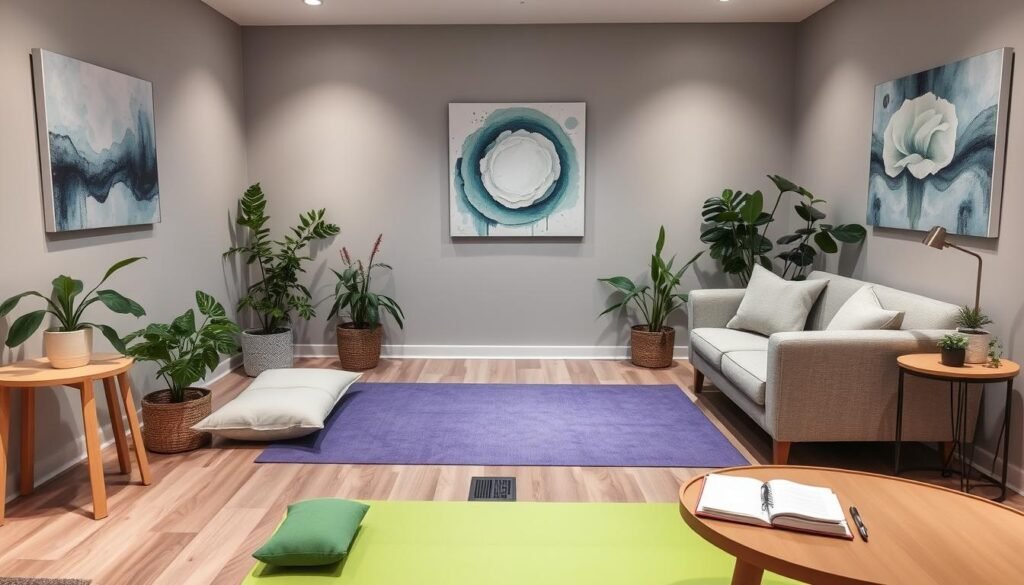About 29 million people watched Kelly McGonigal’s TED Talk called “How to Make Stress Your Friend.” This huge number shows many people want to understand anxiety and its effects on mental health. The New York Times has been a leader in sharing key information on anxiety disorders. It has offered detailed reports on mental health studies. Even though the National Institute of Mental Health (N.I.M.H.) only gives $3 million a year to study anxiety, there’s still a lot we need to learn.
Several articles have pointed out that anxiety disorders can really mess with someone’s life, from just feeling a bit uneasy to having a hard time handling day-to-day tasks. Recently, more than two-thirds of teenagers said they’re worried about finding a job in the future. They’re concerned because artificial intelligence is getting more common. This ongoing research doesn’t just help people understand their own fears. It also shows how our healthcare system often puts mental health on the back burner.
This part will explore anxiety more deeply. We’ll look at what causes it and how people can manage it. The New York Times has done a lot of work to share information on mental health studies.
Key Takeaways
- 29 million viewers engaged with Kelly McGonigal’s talk, emphasizing the public’s interest in anxiety management.
- The N.I.M.H. allocated significantly less funding to anxiety research compared to other mental health issues.
- In 2023, 66% of teens expressed anxiety about job hunting amid advancements in AI technology.
- Anxiety can range from mildly disruptive to crippling, affecting many adults across the country.
- Recent findings in mental health research are crucial for understanding the evolution of anxiety disorders.
- The New York Times consistently updates its readership on important research and expert insights regarding anxiety.
The Nature of Fear and Anxiety
Fear and anxiety are important parts of how we think and feel. They help us react to different situations. Understanding them can teach us a lot about people. Fear usually happens right away when we see danger. Anxiety might grow slowly, thinking about future threats.
Both feelings cause a psychological response. This includes changes in our body, how we act, and how we feel emotionally.
Understanding the Psychological Response
The way we respond to fear and anxiety varies from person to person. Some try to avoid scary things, while others might get very alert. Research shows that 15 to 20 percent of babies are very reactive to new people or places.
This behavior can lead to being shy or anxious around others as they grow. In America, about 40% of people say they’re shy sometimes. This shyness can turn into social anxiety, which is a big problem that we need to study more.
The Biological Mechanisms Behind Anxiety
The science behind anxiety is complicated. It involves different parts of the brain. The amygdala is one key area. If it’s too active, people with anxiety disorders feel very stressed.
This can make their hearts race and raise stress hormone levels. Studies show there’s special brain wiring for anxiety. This can make some people more sensitive to stress. It affects their life and how they interact with others.
Scientific Insights on Anxiety from The NYT
The New York Times shares insights on understanding anxiety disorders. It shows the impact of anxiety and talks about how important treatment is. Cognitive Behavioral Therapy (CBT) is highlighted as a key treatment option.
Recent studies reveal anxiety is now a major mental health issue. It affects about 1 in 3 people at some point in their lives.
Recent Research Findings
Research separates fear from anxiety. Fear is a reaction to immediate threats. Anxiety happens due to worries about future events, causing issues like irritability and sleep problems. Preparing for something like a virtual interview can worsen anxiety, making it crucial to handle effectively.
The Role of Cognitive Behavioral Therapy
Cognitive Behavioral Therapy is a top method for treating anxiety. It changes thinking patterns to fight off anxiety. The New York Times outlines various CBT methods, including mindfulness. Mindfulness focuses on being aware of what you feel and what’s happening in your body.
Want detailed help with CBT? CBT techniques for anxiety offer specific advice for emotional management.
The Neuroscience of Anxiety
The study of anxiety in neuroscience looks at how the brain handles fear. It shows us why we feel anxiety. To tackle anxiety disorders well, knowing how the brain sees dangers is key. The amygdala plays a big part here, handling our fear responses.
How the Brain Processes Fear
When we sense danger, our brain has specific paths it follows. The amygdala is crucial, making our bodies react. This can make our anxiety worse and lead to avoiding things that scare us. Also, with everything connected nowadays, emotions like FOMO hit harder. Having too much information can overwhelm our brains, making anxiety more complex.
Neurological Perspectives on Anxiety Disorders
Anxiety disorders mean our brain reacts oddly to stress. This can be because of our genes, environment, or mental state. Over 40 million adults in the U.S. face these challenges. Understanding how our minds and brains interact is important for future research. Therapies like cognitive behavioral therapy help, yet we also need to look at the brain itself.
For more information, visit this insightful article.
| State | Continuing Education Hours for Counselors | Continuing Education Hours for Social Workers |
|---|---|---|
| California | 1.0 | 1.0 |
| Florida | 1.5 | 1.5 |
| Illinois | 1.5 | 1.5 |
| Kentucky | 1.75 | N/A |
| Missouri | 1.5 | N/A |
| Kansas | N/A | 1.5 |
| Colorado | N/A | 1.5 |
Impact of Anxiety on Mental Health
Anxiety disorders greatly impact mental health, affecting both individuals and communities. Millions of adults in the U.S. suffer due to it. The rising numbers in Generalized Anxiety Disorder statistics show we need to pay more attention.
We must understand anxiety’s effects. It’s not just about personal struggles. It has wider societal implications that need our urgent attention.
Statistics on Generalized Anxiety Disorder
Approximately 19 million U.S. adults battle with generalized anxiety disorder, says the National Institute of Mental Health. This data shows how widespread the issue is. But anxiety research gets about $3 million a year, which is less than other mental health research.
More studies on anxiety are necessary, as federal mental health officials point out. The popularity of the Anti-Anxiety Notebook, with over 100,000 sold, shows people are looking for ways to manage anxiety better.
Societal Implications of Anxiety Disorders
The effects of anxiety on society include economic costs and daily life disruptions. Venture capital firms invested $852 million in mental health tools recently. This marks a 73 percent jump from the year before, showing a growing effort to combat anxiety.
Therapists have been working on anxiety treatment methods since Freud. The pursuit of better treatments continues. For more info on spotting anxiety symptoms, check out this resource here.

Anxiety Management Strategies
Anxiety touches millions every year, driving the need for effective coping methods. Everyday techniques can significantly improve emotional resilience. Mindfulness is a key tool for easing anxiety.
Effective Techniques for Everyday Anxiety
Integrating specific practices helps in managing daily anxiety. Here are some helpful methods:
- Deep Breathing: A simple method, deep breathing lowers stress and promotes calm.
- Journaling: Writing helps explore feelings, offering clarity.
- Time Management: Organized tasks reduce overwhelm, boosting productivity.
- Aerobic Exercise: Physical activity cuts tension, stabilizing mood.
Mindfulness for Anxiety Relief
Mindfulness is well-regarded for easing anxiety. It focuses on being in the moment and includes:
- Meditation: Meditation brings calm, fostering an objective view of our thoughts.
- Mindful Breathing: Concentrating on breathing redirects thoughts from anxiety.
- Body Scan: Attending to body parts relaxes and grounds us.
Studies highlight the value of mindfulness in mental wellness. Regular use of these techniques improves anxiety management. This, in turn, boosts life quality.
| Technique | Purpose | Expected Benefits |
|---|---|---|
| Deep Breathing | Relaxation | Lower stress |
| Journaling | Self-reflection | Better emotional understanding |
| Aerobic Exercise | Physical activity | Enhanced mood, increased self-esteem |
| Mindfulness Meditation | Aware attention | Greater emotional strength |
Exposure Therapy Explained
Exposure therapy is a top method for treating anxiety disorders in teens. It involves confronting fears gradually. By facing their anxieties, individuals can overcome them instead of avoiding them. The New York Times has reported that this approach greatly lowers anxiety symptoms. It works through different therapeutic mechanisms.
Understanding Its Mechanism
The basis of exposure therapy is exposing people to what they fear in steps. It starts with easy scenarios and moves to harder ones. As time goes on, people become less sensitive to their fears, reducing their anxiety. Research shows this is very effective for teens who find daily tasks hard because of anxiety.
Benefits of Confronting Fears
There are many good things about facing fears with exposure therapy. It helps improve how people cope and makes them stronger. For example, at a residential treatment center, patients use this method to beat anxiety disorders. Stories tell of how facing fears changes lives. It lets teens achieve their goals, like getting high grades or carrying on a family tradition at top schools. They say exposure therapy gives them the skills to handle anxiety, greatly improving their lives.

If you’re interested in learning more about treating anxiety in kids and teens, check out this article on different therapy strategies.
The Role of Environment in Anxiety
The link between our surroundings and mental health is getting more focus lately. Things like how much money people have and worldwide issues deeply affect our mental wellness. By exploring how these factors are connected, we gain insights into what different communities go through.
Effects of Socioeconomic Status on Anxiety Levels
Your economic status has a big impact on how anxious you might feel. People with less money often face more stress in their daily lives. This stress can come from not having easy access to schooling, healthcare, or steady jobs. These issues can make feelings of anxiety worse. Plus, being in these situations can make it harder to find ways to cope with stress, leaving people more open to mental health problems.
How Global Crises Influence Mental Health
Worldwide issues like climate change and political conflicts add to anxiety. Studies have shown that climate change is linked to more violence, affecting many communities. For instance, rising temperatures reduce resources, leading to disasters that hurt people’s mental state. The Pentagon pointed out that droughts and lower crop production helped start the Syrian civil war. This shows the strong connection between environmental problems and more anxiety.
Terms like “eco-anxiety” describe the worry people feel about the planet. Shows like the “Hot Take” and “Drilled” talk about climate issues, showing that more people are becoming uneasy about our changing world. Educational materials that discuss how the environment is getting worse or the effects of ignoring climate change stress the need to understand how these crises impact our anxiety.
| Environmental Factor | Impact on Anxiety | Examples |
|---|---|---|
| Socioeconomic Status | Increased stress and limited coping mechanisms | Low-income neighborhoods lacking resources |
| Climate Change | Fear of natural disasters and resource scarcity | Droughts leading to food insecurity |
| Global Crises | Political unrest and its psychological consequences | Syria’s civil war fueled by environmental stressors |
Therapy Techniques for Anxiety Management
It’s key to know about therapy techniques for better anxiety management. Different methods meet different needs, helping people cope better. Each one has special features that might suit various people, aiding in their path to better mental health.
The Effectiveness of Different Approaches
There are many ways to manage anxiety, like one-on-one therapy, group sessions, and medication. One-on-one therapy mainly uses cognitive-behavioral techniques. It helps patients question and change thoughts that cause anxiety. Yet, some might feel alone in their struggle.
Group therapy, on the other hand, builds community. People share experiences, feeling less alone and getting social support. Studies show group settings offer a safe place to face fears and learn coping skills. This makes managing anxiety more effective.
Benefits of Group Therapy
Group therapy has many benefits compared to one-on-one sessions. Some key advantages are:
- Social Support: Connecting with others facing similar issues builds empathy and understanding.
- Shared Experiences: Hearing others’ stories gives a strong sense of belonging and comfort.
- Cost-Effectiveness: Group therapy is generally cheaper than individual sessions.
- Skill Development: Group members can practice coping strategies together and get feedback.

| Therapy Technique | Target Group | Effectiveness | Key Features |
|---|---|---|---|
| Individual Therapy | Adults & Adolescents | High | Personalized strategies, tailored discussions |
| Group Therapy | Adults & Adolescents | Moderate to High | Peer support, shared goals, interactive learning |
| Pharmacological Treatment | Patients with severe anxiety | High | Medication management, often combined with therapy |
Using a mix of therapy methods can improve anxiety management. Adding group therapy benefits to individual approaches improves support and effectiveness. This way, therapists can offer better help to their patients.
The Cultural Perspective on Anxiety
Anxiety looks different in various cultures. It’s shaped by what society expects of us. Recognizing how culture affects anxiety is key to helping those struggling. Studies from around the world show that anxiety isn’t the same everywhere. This tells us that where you live can influence how you feel anxiety.
Differences in Anxiety Across Countries
Cultural attitudes play a big role in anxiety levels from one country to another. For instance, in societies where people work closely together, expectations can make anxiety worse. On the other hand, cultures that value independence tend to talk more openly about anxiety. This openness can lead to better support and more options for treatment. It’s crucial to understand these differences to provide the right help.
Comparative Studies on Global Anxiety Trends
Global studies on anxiety look at factors like wealth, education, and how societies are structured. They find that people with less money often feel more anxious. This is because they face more uncertainty and have fewer mental health resources. Social media also plays a part, making more people feel connected but also more anxious. Knowing these factors helps in creating effective ways to teach and help those affected.
Mindfulness and Its Benefits for Anxiety
Mindfulness is a key tool in fighting anxiety. It brings many benefits that boost mental health. People can see big changes in how they feel by using mindfulness daily. In this part, we’ll look at how to make mindfulness part of your life. We’ll also see what research says about how well it works.
Techniques to Incorporate Mindfulness into Daily Life
Using mindfulness each day can really change things for you. Here are some good ways to do it:
- Mindful Breathing: Pay attention to your breathing. Take deep breaths in and out. This helps keep your mind in now.
- Body Scan: Notice how each part of your body feels. This helps connect your mind and body better.
- Mindful Walking: When you walk, really notice everything around you. Focus on how moving feels and what you see.
- Daily Reflection: Take a bit of time each day to think about your thoughts and feelings. Do this without judging yourself.
Research Supporting Mindfulness Practices
Many studies show mindfulness is great for handling anxiety. It helps with thinking and controlling emotions. Ellen Langer’s work in the 1970s showed small mindfulness steps could change thoughts and feelings a lot. Recent studies agree with her, showing that we spend about 47% of our time overthinking. Mindfulness can help reduce this.
Mindfulness also helps us stay in the present. It’s good for blocking out distractions we face today. Though it might be hard at first, because our minds wander, sticking with it helps us get better. This is why mindfulness is used a lot in therapy. It’s helpful for people trying to deal with anxiety, stress, and similar problems.
Conclusion
This article has looked into how our brains and thoughts work together to make us feel anxious. It shows that more and more people, especially the young, are facing mental health challenges. The New York Times has shared insights, pointing out how tech affects our mental well-being, stressing the need for more research.
Studies suggest that as people get older, their anxiety levels might change. For those in middle age, there’s a higher risk of depression linked to brain changes. This fact highlights the need for support and new therapy methods. Techniques like cognitive-behavioral therapy are gaining ground. They help build resilience and better mental health.
Keeping up-to-date with mental health methods is key. Mixing physical exercises with therapy can really help beat anxiety and boost emotional wellness. For more info on mental health, check out this link. By learning more about anxiety, we can all work towards a happier life. It’s something we should all try to do for a healthier community.